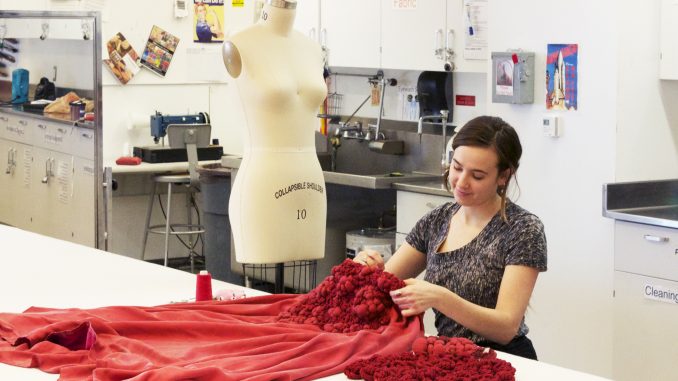
One of Sienna Martz’s first experiences creating wearable art was in 2012, when she stood in front of her classmates in a translucent gown that she made from organza.
“[Martz] did the critique in this see-through outfit – a gorgeous hand-dyed and sculpted organza piece,” said Lorraine Glessner, Martz’s former professor in the fiber and materials department of Tyler School of Art. “But, that’s who she is. I don’t mean to make her out to be an exhibitionist or anything like that, but she just goes above and beyond.”
Martz was a sculpture major, although she calls herself a fiber artist. After graduating in December 2013, she continued gaining more experience creating haute couture gowns.
In June 2013, Martz was awarded a grant from the Seol Won Foundation after Dr. Young Yang Chung, director of the Chung Young Yang Embroidery Museum in Seoul, South Korea, saw Martz’s online portfolio. The grant was awarded to create a gown for the museum’s 10th anniversary exhibition entitled “Wearable Art: Inspiration in Thread,” which opened on Oct. 8.
The gown, hand-dyed red from dyes like chestnut and paprika and made from silk, will be held in the museum’s center display case through December.
“I pulled from the idea that silk is very important in Korean art,” Martz said. “I decided to hand-dye the entire piece, which is a very intimate, labor-intensive process. But, I felt like it was important to me to have that involvement and control over the color palette that I was creating.”
Martz said she spent at least 500 hours over the span of a year and a half working on the gown. She researched the way she would create a gown to fit with the contemporary exhibition that intertwined Dr. Young Yang Chung’s traditional collection of Asian embroidery art.
During her artist-in-residence at Tyler in Spring 2014, Martz received help making the gown from Glessner and former Tyler professor Pazia Mannella.
“The embroidery on the gown created is unique because of the scale size of the silk rope,” Mannella said in an email. “The skirt’s texture references a traditional embroidery stitch, French knots, at an exaggerated scale.”
Although Martz is one of 21 artists featured in the museum’s exhibit, she said she was not formally trained in dressmaking.
“My degree was in sculpture, but I’ve been heavily influenced by fibers and wearable art,” Martz said. “I had basic skills, but I really had to teach myself how to make a gown because that hasn’t been my training. That was very challenging, but a very thrilling experience.”
Martz’s sculpture experience still plays a role in her work, she said.
“The connection with my sculpture and my wearables is a bodily influence,” Martz said. “For my wearables, I view the body as my canvas. I like to create structures built up onto the body and have the interaction of the movement of the body with my piece.”
Glessner said she would describe Martz’s work as very organic, mixing nature and the body.
“The role textiles and garments play in human experience, unique among cultures, ideological classes and racial identities fascinate [Martz] and me,” Mannella said.
Although she plans to come back to Philadelphia after the exhibition, Martz said after spending time enjoying the culture of Seoul, she then plans to travel to Beijing, Vietnam, Thailand and Indonesia.
“I figured, if I’m already here in Asia, I might as well really experience as many countries and cultures as I can,” Martz said.
Kerri Ann Raimo can be reached at kerriann.raimo@temple.edu


Be the first to comment